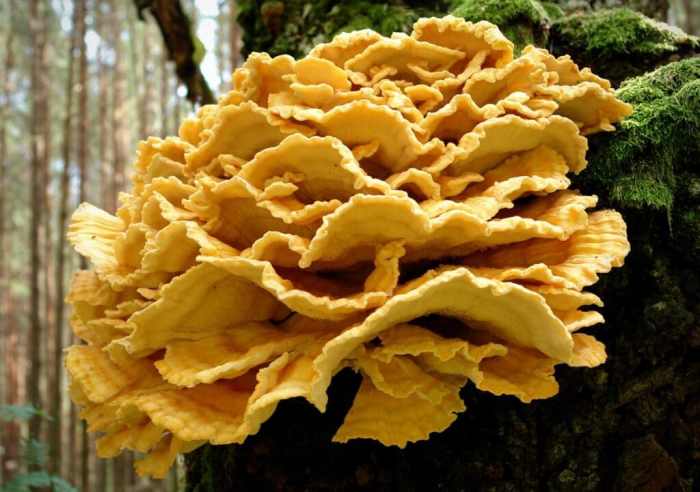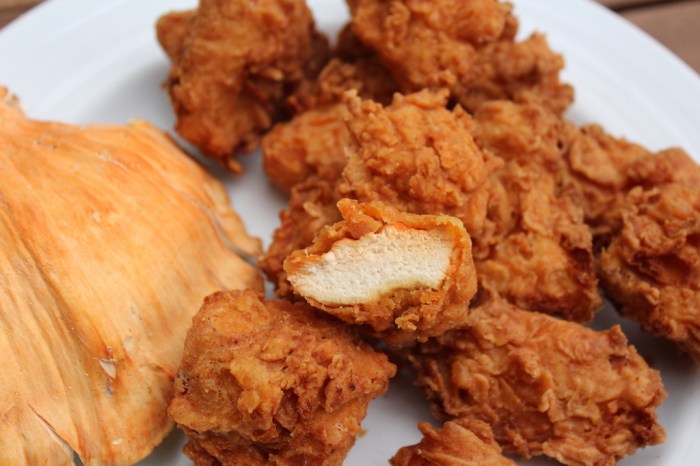
Embark on a culinary adventure with chicken of the woods recipe, an extraordinary edible mushroom that delights the taste buds with its unique flavor and texture. From sautéing to roasting and pickling, this versatile ingredient offers a plethora of culinary possibilities.
Dive into the world of chicken of the woods, where foraging enthusiasts and mycophiles alike uncover the secrets of identifying this wild delicacy. With its vibrant colors and distinct shape, this mushroom is a joy to discover in the heart of nature.
Culinary Profile
Chicken of the Woods is known for its unique flavor and texture, resembling that of chicken meat. It has a slightly meaty, savory taste with a hint of sweetness, making it a versatile ingredient in various culinary preparations.
This edible mushroom can be used in various ways, including sautéing, roasting, pickling, and more. When sautéed, Chicken of the Woods develops a crispy exterior and a tender, juicy interior, making it a great addition to stir-fries, omelets, and pasta dishes.
If you’re a fan of foraging, you’ll definitely want to try out this chicken of the woods recipe . It’s a delicious and easy way to enjoy this unique mushroom. Chicken of the woods has a meaty texture and a slightly nutty flavor, making it a great substitute for chicken in many dishes.
Roasting intensifies its flavor, creating a caramelized crust that pairs well with roasted vegetables, meats, and hearty stews.
Nutritional Value
Chicken of the Woods is not only delicious but also packed with nutrients. It is a good source of protein, fiber, and essential vitamins and minerals. The table below compares the nutritional value of Chicken of the Woods to other edible mushrooms:
| Nutrient | Chicken of the Woods | Shiitake Mushrooms | White Button Mushrooms |
|---|---|---|---|
| Calories | 22 | 15 | 4 |
| Protein | 3g | 2g | 1g |
| Fiber | 2g | 1g | 1g |
| Vitamin D | 10 IU | 0 IU | 0 IU |
| Potassium | 200mg | 120mg | 50mg |
Foraging and Identification

Identifying Chicken of the Woods in the wild requires keen observation and knowledge of its distinctive characteristics. Here’s a comprehensive guide to help you confidently forage this edible delicacy:
Chicken of the Woods is a polypore mushroom, meaning it has pores on the underside of its cap instead of gills. It typically grows in clusters on the trunks or stumps of oak, maple, and other hardwood trees. The cap is shelf-like, with a vibrant orange to yellow color and a velvety texture.
As the mushroom matures, the cap may develop dark orange or brown spots.
If you’re a fan of rustic flavors, you’ll adore the chicken of the woods recipe that calls for sautéing the fungus in a cast-iron skillet. The crispy edges and earthy undertones will tantalize your taste buds and leave you yearning for more.
Geographical Distribution
Chicken of the Woods has a wide geographical distribution, found in North America, Europe, and Asia. It is most commonly encountered in temperate forests during the spring, summer, and fall months.
Similar-Looking Mushrooms
It is crucial to be able to distinguish Chicken of the Woods from similar-looking mushrooms to avoid potential toxicity. Here’s a table with images and descriptions of mushrooms that could be mistaken for Chicken of the Woods:
| Mushroom | Image | Description |
|---|---|---|
| False Chicken of the Woods (Laetiporus sulphureus) | [Image of False Chicken of the Woods] | Similar in appearance to Chicken of the Woods, but with a more sulfur-yellow color and a slightly bitter taste. It is edible, but less flavorful than Chicken of the Woods. |
| Orange Pore Fungus (Phaeolus schweinitzii) | [Image of Orange Pore Fungus] | A parasitic mushroom that grows on conifer trees. It has a bright orange cap with a rough, crusty texture and is not edible. |
| Velvet-Top Fungus (Phellinus gilvus) | [Image of Velvet-Top Fungus] | A perennial mushroom that grows on hardwood trees. It has a dark brown to black cap with a velvety texture and is not edible. |
Recipe Exploration

Chicken of the Woods is a versatile mushroom that can be used in a variety of recipes. Here are a few ideas to get you started:
Sautéed
- Sautéed Chicken of the Woods with Garlic and Herbs
- Sautéed Chicken of the Woods with Butter and Lemon
- Sautéed Chicken of the Woods with Onions and Peppers
Roasted
- Roasted Chicken of the Woods with Olive Oil and Salt
- Roasted Chicken of the Woods with Vegetables
- Roasted Chicken of the Woods with a Maple Glaze
Pickled
- Pickled Chicken of the Woods
- Sweet and Sour Pickled Chicken of the Woods
- Spicy Pickled Chicken of the Woods
Creative Culinary Applications
In addition to these basic recipes, Chicken of the Woods can also be used in a variety of creative culinary applications. Here are a few ideas:
- Chicken of the Woods Soup
- Chicken of the Woods Stew
- Chicken of the Woods Sauce
Health Benefits

Chicken of the Woods is not only a culinary delight but also a potential source of health benefits. Studies have shown that it possesses antioxidant and anti-inflammatory properties, which may contribute to overall well-being.
Craving a meaty treat without the guilt? Look no further than chicken of the woods , a vibrant fungus that mimics the taste and texture of chicken. This culinary wonder is easy to find in the wild and can be transformed into a delectable meal with minimal effort.
Antioxidants, such as ergothioneine and beta-glucans, help neutralize free radicals, which are unstable molecules that can damage cells and contribute to chronic diseases. Chicken of the Woods is a rich source of these antioxidants, making it a potential ally in combating oxidative stress and protecting against age-related conditions.
Anti-inflammatory Properties, Chicken of the woods recipe
Chicken of the Woods also exhibits anti-inflammatory properties. Inflammation is a natural response to injury or infection, but chronic inflammation can contribute to various health issues. Compounds in Chicken of the Woods, such as polysaccharides and triterpenoids, have been shown to inhibit the production of inflammatory cytokines, reducing inflammation and potentially mitigating conditions like arthritis and inflammatory bowel disease.
Moreover, Chicken of the Woods is a good source of dietary fiber, which supports a healthy digestive system and promotes satiety. Its low-calorie content makes it a suitable dietary choice for weight management.
Nutritional Profile
Chicken of the Woods is a nutrient-rich mushroom. It is an excellent source of:
| Nutrient | Health Benefits |
|---|---|
| Vitamin D | Bone health, immune function |
| Vitamin C | Antioxidant, immune support |
| Potassium | Blood pressure regulation, muscle function |
| Fiber | Digestive health, satiety |
| Ergothioneine | Antioxidant, neuroprotective |
Cultivation and Preservation: Chicken Of The Woods Recipe

Cultivating Chicken of the Woods at home can be a rewarding experience. With proper care, you can enjoy fresh, homegrown mushrooms for years to come. This section will guide you through the process of cultivating and preserving Chicken of the Woods.
Cultivation
Chicken of the Woods can be cultivated on logs or sawdust substrate. To cultivate on logs, choose healthy logs of hardwood species such as oak, maple, or beech. Drill holes into the logs and insert mushroom spawn plugs. Keep the logs moist and shaded, and in 6-12 months, you should start to see mushrooms fruiting.
To cultivate on sawdust substrate, mix sawdust with bran and gypsum. Moisten the mixture and pack it into containers. Insert mushroom spawn and incubate the containers in a warm, dark place. Once the mycelium has colonized the substrate, move the containers to a fruiting chamber with high humidity and light.
Preservation
Chicken of the Woods can be preserved through drying, freezing, or canning. Drying is the simplest method and can be done in a dehydrator or oven. Freeze Chicken of the Woods in airtight containers for up to 6 months. Canning is a more complex method but allows for longer storage times.
| Preservation Method | Steps | Safety Precautions |
|---|---|---|
| Drying |
|
|
| Freezing |
|
|
| Canning |
|
|
Final Conclusion

As we bid farewell to our exploration of chicken of the woods recipe, let the newfound knowledge and culinary inspiration ignite your passion for this extraordinary mushroom. Whether you’re a seasoned chef or a novice cook, the recipes and insights shared here will empower you to create mouthwatering dishes that celebrate the flavors of nature.
FAQ Insights
Is chicken of the woods safe to eat?
Yes, chicken of the woods is generally considered safe to eat when properly cooked.
How do I identify chicken of the woods?
Look for mushrooms with bright orange to yellow colors, a ruffled or lobed shape, and a white or cream-colored spore surface.
What are the health benefits of chicken of the woods?
Chicken of the woods is rich in antioxidants and has potential anti-inflammatory properties.






